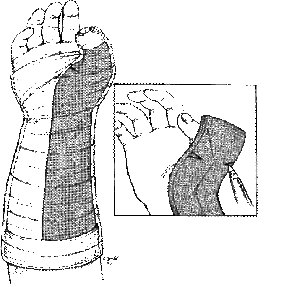Thumb spica splint
Background
- Notching the splinting material (shown) prevents buckling when wrapping around thumb.
Indications
- Scaphoid fracture - seen or suspected (check snuffbox tenderness)
- De Quervain tenosynovitis / other ligamentous or soft tissue injuries to thumb
- Nonangulated, nondisplaced, extra-articular fractures of the base of the first metacarpal [1]
Procedure

- Assess distal pulse, motor, and sensation
- Apply padding and splint material (e.g. Ortho-glass) to the radial aspect of the forearm and covering the thumb as shown
- Wrist should be in slight extension (approximately 20°) with thumb in functional position (ask patient to envision "holding a soda can")
- Maintain positioning until splint material hardens and secure splint to forearm
- Reassess distal pulse, motor, and sensation
See Also
References
- Splints and Casts: Indications and Methods http://www.aafp.org/afp/2009/0901/p491.html Accessed April 6, 2017
This article is issued from
Wikem.
The text is licensed under Creative
Commons - Attribution - Sharealike.
Additional terms may apply for the media files.